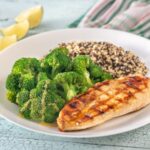Embark on a culinary journey to a healthier heart! “Eat Your Way to Wellness: Heart-Healthy Recipes You’ll Love” unveils a treasure trove of delicious, easy-to-prepare recipes designed to nourish your body and delight your taste buds. This guide isn’t just about eating right; it’s about embracing a lifestyle change that’s both satisfying and sustainable. We’ll explore vibrant ingredient profiles, discover simple cooking techniques, and create a weekly meal plan that makes heart-healthy eating a breeze. Prepare to transform your relationship with food and unlock the path to a healthier, happier you.
From quick weeknight dinners to insightful ingredient spotlights, this resource provides a comprehensive approach to heart-healthy eating. Learn to identify key ingredients that boost heart health, master portion control, and adapt recipes to suit various dietary needs. Visual guides and step-by-step instructions make this a practical and accessible guide for everyone, regardless of their cooking experience. Get ready to savor the flavors of wellness and cultivate a vibrant, energetic life.
Heart-Healthy Recipe Ideas
Choosing the right foods is crucial for maintaining a healthy heart. These five simple recipes are designed for busy weeknights, using readily available ingredients and minimizing preparation time, while maximizing nutritional benefits for cardiovascular health. Each recipe is estimated to serve four people.
Heart-Healthy Recipe Details
The following table Artikels five delicious and heart-healthy recipes, perfect for a busy week. Each recipe emphasizes lean protein, plenty of vegetables, and healthy fats, contributing to a balanced diet that supports cardiovascular health. Calorie counts are estimates and may vary based on specific ingredients and portion sizes.
| Recipe Name | Ingredients | Summary | Calories (per serving) |
|---|---|---|---|
| Mediterranean Salmon with Roasted Vegetables | Salmon fillets, zucchini, bell peppers, red onion, cherry tomatoes, olive oil, lemon juice, oregano, garlic | Salmon, rich in Omega-3 fatty acids, is baked alongside colorful roasted vegetables, creating a vibrant and flavorful meal. The olive oil provides healthy monounsaturated fats. | Approximately 450 |
| Lentil Soup with Spinach | Lentils, vegetable broth, carrots, celery, onion, spinach, garlic, cumin, turmeric | This hearty soup is packed with fiber from lentils and spinach, promoting healthy digestion and lowering cholesterol. Turmeric adds an anti-inflammatory boost. | Approximately 300 |
| Chicken and Quinoa Salad with Avocado | Grilled chicken breast, cooked quinoa, avocado, chopped cucumber, cherry tomatoes, red onion, lemon vinaigrette | This vibrant salad offers lean protein from chicken, fiber from quinoa, and healthy fats from avocado. The lemon vinaigrette adds a zesty flavor. | Approximately 380 |
| Turkey Meatloaf with Sweet Potato Mash | Ground turkey, breadcrumbs, egg, onion, garlic, oats, ketchup, sweet potatoes, milk | Lean ground turkey replaces traditional ground beef in this meatloaf, reducing saturated fat. The sweet potato mash provides complex carbohydrates and vitamin A. | Approximately 420 |
| Shrimp Scampi with Zucchini Noodles | Shrimp, zucchini (spiralized), garlic, lemon juice, white wine (optional), olive oil, red pepper flakes | This lighter take on shrimp scampi uses zucchini noodles instead of pasta, reducing carbohydrates and calories while maintaining a delicious flavor profile. | Approximately 350 |
Meal Planning for Heart Health
Creating a weekly meal plan tailored to heart health involves careful consideration of ingredients, portion sizes, and overall dietary balance. A well-structured plan can significantly contribute to lowering cholesterol, managing blood pressure, and promoting overall cardiovascular well-being. This section provides a sample plan and demonstrates how to adapt it to individual needs.
Sample Weekly Meal Plan
A balanced diet is key to maintaining heart health. This sample plan incorporates a variety of fruits, vegetables, whole grains, lean proteins, and healthy fats. Remember to adjust portion sizes based on your individual caloric needs and activity level.
| Day | Meal | Recipe/Description |
|---|---|---|
| Monday | Breakfast | Oatmeal with berries and a sprinkle of nuts. (Imagine a creamy bowl of oatmeal, the soft texture contrasting with the juicy bursts of berries and the satisfying crunch of nuts.) |
| Monday | Lunch | Large salad with grilled chicken or fish, mixed greens, and a light vinaigrette. (Picture a vibrant salad overflowing with colorful vegetables, the lean protein adding substance, all lightly dressed with a tangy vinaigrette.) |
| Monday | Dinner | Baked salmon with roasted vegetables (broccoli, carrots, peppers). (Envision flaky salmon, its skin glistening slightly, nestled amongst tender-crisp roasted vegetables, their natural sweetness enhanced by the roasting process.) |
| Tuesday | Breakfast | Greek yogurt with fruit and a drizzle of honey. (A creamy, tangy yogurt, studded with pieces of fresh fruit, the subtle sweetness of honey complementing the natural flavors.) |
| Tuesday | Lunch | Lentil soup with a whole-wheat roll. (A hearty and flavorful lentil soup, its rich color hinting at its nutritious contents, accompanied by a crusty, wholesome roll.) |
| Tuesday | Dinner | Chicken stir-fry with brown rice. (Imagine a colorful stir-fry, the chicken tender and the vegetables vibrant, all served over fluffy brown rice.) |
| Wednesday | Breakfast | Whole-wheat toast with avocado and a poached egg. (Picture a slice of whole-wheat toast, topped with creamy avocado and a perfectly poached egg, its yolk glistening.) |
| Wednesday | Lunch | Leftover chicken stir-fry. |
| Wednesday | Dinner | Vegetarian chili with cornbread. (A hearty and flavorful chili, packed with beans and vegetables, accompanied by a slightly sweet cornbread.) |
| Thursday | Breakfast | Smoothie with spinach, banana, and almond milk. (A vibrant green smoothie, its creamy texture hinting at the delicious blend of fruits and vegetables.) |
| Thursday | Lunch | Tuna salad sandwich on whole-wheat bread. (A classic tuna salad, made with light mayonnaise and served on hearty whole-wheat bread.) |
| Thursday | Dinner | Turkey meatballs with zucchini noodles. (Picture lean turkey meatballs, their texture light and flavorful, served over delicate zucchini noodles.) |
| Friday | Breakfast | Oatmeal with fruit and nuts. |
| Friday | Lunch | Leftover turkey meatballs and zucchini noodles. |
| Friday | Dinner | Heart-healthy pizza with whole-wheat crust, vegetables, and low-fat cheese. (Imagine a delicious pizza, its whole-wheat crust providing a wholesome base, topped with an array of colorful vegetables and a light layer of cheese.) |
| Saturday | Breakfast | Scrambled eggs with whole-wheat toast. |
| Saturday | Lunch | Salad with grilled chicken or fish. |
| Saturday | Dinner | Grilled chicken breast with quinoa and steamed asparagus. (Picture a juicy grilled chicken breast, its flavors enhanced by grilling, served with fluffy quinoa and tender asparagus.) |
| Sunday | Breakfast | Pancakes made with whole-wheat flour and topped with berries. (Imagine fluffy pancakes, made with wholesome whole-wheat flour, their lightness contrasted by the sweetness and juiciness of fresh berries.) |
| Sunday | Lunch | Leftover grilled chicken and quinoa. |
| Sunday | Dinner | Lentil stew with whole-grain bread. (A rich and hearty lentil stew, its flavors enhanced by a variety of spices, served with a slice of wholesome whole-grain bread.) |
Adapting the Meal Plan
This sample meal plan can be easily adapted to suit individual preferences and dietary restrictions. For example:
* Vegetarian/Vegan: Substitute chicken and fish with plant-based protein sources like tofu, beans, lentils, or tempeh.
* Gluten-Free: Replace whole-wheat bread and pasta with gluten-free alternatives.
* Dairy-Free: Use dairy-free milk alternatives in smoothies and oatmeal, and opt for dairy-free cheese alternatives.
* Allergies: Carefully check ingredient lists and avoid any foods that trigger allergies.
* Specific Dietary Needs: Consult with a doctor or registered dietitian to create a personalized meal plan that addresses specific dietary needs, such as low-sodium or low-fat diets. They can help you create a meal plan that aligns with your health goals and medical recommendations.
Visual Guide to Portion Control and Serving Sizes

Understanding portion sizes is crucial for maintaining a heart-healthy diet. Visualizing the correct amounts of food can be more effective than relying solely on numbers, helping you intuitively gauge appropriate servings and avoid overeating. This guide provides visual representations and practical strategies for accurate portion control at home.
Visualizing Heart-Healthy Portion Sizes
Imagine a deck of cards. A serving of meat, poultry, or fish should be roughly the size of a deck of cards – approximately 3 ounces. This translates to a piece of salmon about the size of your palm, or a chicken breast about the thickness of your thumb. For grains, a portion of cooked rice, pasta, or quinoa is akin to the size of a tennis ball – about ½ cup. A serving of fruits and vegetables, such as a handful of berries or a medium-sized apple, should be about the size of your fist. Finally, a serving of healthy fats, like nuts or avocado, is roughly the size of a golf ball – about 1-2 tablespoons. These visual cues provide a quick and easy way to estimate appropriate portion sizes without needing measuring cups or scales.
Methods for Measuring Food Portions at Home Without Measuring Tools
Accurately measuring portions without specialized tools is achievable using readily available household items. A standard coffee mug often holds approximately one cup, useful for measuring grains or soups. Your hands can serve as useful guides; a cupped hand can represent about one cup of salad, while your thumb represents about one tablespoon of peanut butter. Using common tableware can also assist. A small dinner plate (about 9 inches in diameter) is suitable for most meals, preventing you from piling food high. Remember, consistency is key. Use the same plate and cup regularly to maintain consistency in your portion sizes.
Strategies for Maintaining Healthy Portion Sizes Throughout the Week
Consistency in portion control is paramount. Start by planning your meals ahead of time, ensuring you have the right amounts of food prepared. This reduces the likelihood of impulsive overeating. Eat slowly and mindfully, paying attention to your body’s hunger and fullness cues. Put your fork down between bites and take the time to savor your food. Distraction-free eating environments are also important; avoid eating while watching television or working on your computer. Consider using smaller plates and bowls to visually reduce portion sizes, and regularly review your food choices and portion sizes to ensure they align with your heart-healthy goals. Finally, remember that occasional indulgences are acceptable. Don’t strive for perfection; focus on consistent healthy habits.
Rediscovering the joy of cooking and eating well doesn’t have to be daunting. “Eat Your Way to Wellness: Heart-Healthy Recipes You’ll Love” empowers you to take control of your heart health through simple, delicious meals. By incorporating the recipes, meal plan, and nutritional insights shared here, you’ll be well on your way to a healthier lifestyle. Remember, each meal is an opportunity to nourish your body and invest in your well-being. Embrace the journey, enjoy the flavors, and celebrate the positive impact of mindful eating on your heart health and overall vitality.
Questions Often Asked
Can I substitute ingredients in the recipes?
Yes, many recipes offer suggestions for substitutions. Always consider the nutritional impact of any changes.
Are these recipes suitable for children?
Most recipes can be adapted for children, but adjust portion sizes accordingly and consider their preferences.
How long do the prepared meals last in the refrigerator?
Refrigerate leftovers promptly and consume within 3-4 days for optimal freshness and safety.
What if I have specific allergies or intolerances?
Carefully review the ingredients list for each recipe and make appropriate substitutions based on your dietary needs. Consult a doctor or registered dietitian for personalized advice.


